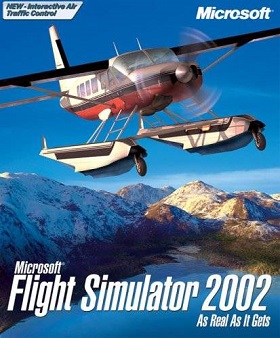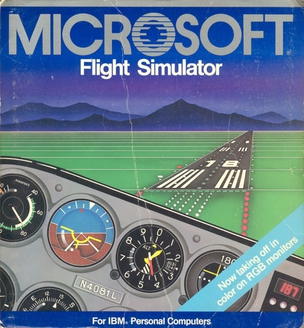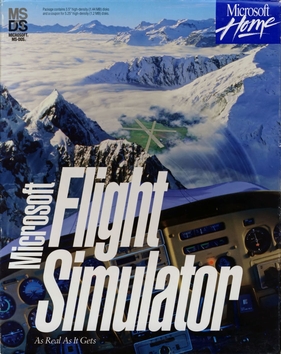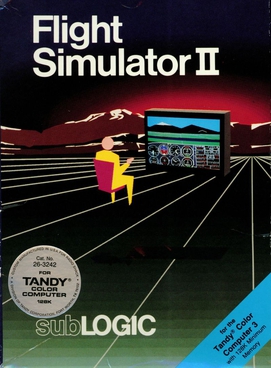
Microsoft Flight Simulator is a series of flight simulator programs for MS-DOS, Classic Mac OS and Microsoft Windows operating systems. It was an early product in the Microsoft application portfolio and differed significantly from Microsoft's other software, which was largely business-oriented. As of November 2022, Microsoft Flight Simulator is the longest-running software product line for Microsoft, predating Windows by three years. Microsoft Flight Simulator is one of the longest-running PC video game series of all time.

Fly! is a flight simulator video game for Windows and Macintosh developed by Terminal Reality and published by Gathering of Developers.

Microsoft Flight Simulator 98, abbreviated commonly as FS98, is a flight simulator video game. It was released in September 1997 for Microsoft Windows.

Microsoft Flight Simulator 2002 also known as FS2002, is a video game released in October 2001, and is the 8th installment of the Microsoft Flight Simulator video game series. A version called Professional Edition was released at the same time as standard edition that added two aircraft, a flight instructor feature, and an editor to create buildings and aircraft.
Microsoft Flight Simulator began as a set of articles on computer graphics, written by Bruce Artwick throughout 1976, about flight simulation using 3-D graphics. When the editor of the magazine told Artwick that subscribers were interested in purchasing such a program, Artwick founded Sublogic Corporation to commercialize his ideas. At first the new company sold flight simulators through mail order, but that changed in January 1979 with the release of Flight Simulator (FS) for the Apple II. They soon followed this up with versions for other systems and from there it evolved into a long-running series of computer flight simulators.

Microsoft Flight Simulator X is a 2006 flight simulation video game originally developed by Aces Game Studio and published by Microsoft Game Studios for Microsoft Windows. It is the sequel to Microsoft Flight Simulator 2004 and the tenth installment of the Microsoft Flight Simulator series, which was first released in 1982. It is built on an upgraded graphics rendering engine, showcasing DirectX 10 features in Windows Vista and was marketed by Microsoft as the most important technological milestone in the series at the time. FSX is the first version in the series to be released on DVD media.

Microsoft Flight Simulator 2004: A Century of Flight is a flight simulation video game released in 2003, and is part of the Microsoft Flight Simulator video game series. It is the last version to support Windows 98/9x series of operating systems. A set of two third-party add-ons were released in 2004 and 2006, titled Wings of Power.

Combat Flight Simulator 3: Battle for Europe (CFS3), is the latest installment of combat flight simulators from Microsoft Game Studios, released on October 24, 2002 in North America and on November 15, 2002 in Europe for the Microsoft Windows.

Microsoft Combat Flight Simulator: WWII Europe Series is the first version of all three combat flight simulation games from Microsoft. It was released on 28 October 1998 and it is set in the European Theatre of World War II. This game spawned two sequels: Combat Flight Simulator 2 in 2000 and Combat Flight Simulator 3: Battle for Europe in 2002.

Jane's World War II Fighters is the 1998 combat flight simulation video game. Set in the European theatre of operations during World War II, it is part of the Jane's Combat Simulations franchise. The game was considered a commercial failure, and contributed to the end of the Jane's Combat Simulations line.

Longbow 2 is the sequel to Jane's AH-64D Longbow from Jane's Combat Simulations. The game was developed by Origin Systems with executive producer Andy Hollis on board, and released by Electronic Arts on November 13, 1997.

Crimson Skies is an arcade flight video game developed by Zipper Interactive and published in 2000 by Microsoft Games. Although a flight-based game, Crimson Skies is not a genuine flight simulator, as the game is based less on flight mechanics than on action. According to series creator Jordan Weisman, Crimson Skies is "not about simulating reality—it's about fulfilling fantasies".

Microsoft Flight Simulator for Windows 95, abbreviated commonly as FS95, is a flight simulator video game. It was released in late 1996 for Windows.

Microsoft Flight Simulator, commonly known as Microsoft Flight Simulator 1.0, is a flight simulator video game, released in November 1982 for the IBM PC. It is the first release in the Microsoft Flight Simulator series.

Microsoft Flight Simulator, commonly known as Microsoft Flight Simulator 2.0 or FS2, is a flight simulator video game. It was released in 1984 for the IBM PC as a self-booting disk.

Microsoft Flight Simulator, commonly known as Microsoft Flight Simulator 3.0 or FS3, is a flight simulator video game. It was released in mid-1988 for the MS-DOS.

Microsoft Flight Simulator, commonly known as Microsoft Flight Simulator 4.0 or FS4, is a 1989 video game developed by Bruce Artwick Organization and published by Microsoft.

Microsoft Flight Simulator, commonly known as Microsoft Flight Simulator 5.0 or FS5, is a flight simulator video game. It was released in late 1993 for the MS-DOS. A port for PC-98 was released in 1994. It was the last game in the series for DOS and the last game to appear on a non-Microsoft platform. An updated version, 5.1, was released in 1995. In November 1995, Microsoft acquired the Bruce Artwick Organization (BAO) from Bruce Artwick. Employees were moved to Redmond, Washington, and development of the series continued in-house at Microsoft.

Flight Simulator II is a video game developed by Bruce Artwick and published by Sublogic as the sequel to FS1 Flight Simulator. It was released in December 1983 for the Apple II, in 1984 for Atari 8-bit and Commodore 64, in 1986 for the Amiga and Atari ST, the Atari XEGS as a pack-in title in 1987 and in August 1988 for the Color Computer 3.

Microsoft Flight Simulator is an amateur flight simulator developed by Asobo Studio and published by Xbox Game Studios. It is an entry in the Microsoft Flight Simulator series which began in 1982, and was preceded by Microsoft Flight Simulator X in 2006. The game is a return of the series after 14 years, with development beginning six years prior to its release. It was released on August 18, 2020, for Windows, with a virtual reality (VR) version released in December of the same year as part of the free Sim 2 update. Microsoft Flight Simulator is the first game in the series to see a VR and console release, with it being released on the Xbox Series X and Series S on July 27, 2021.



















